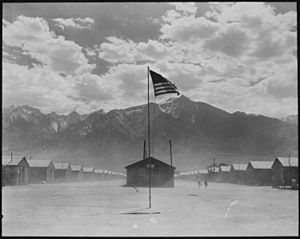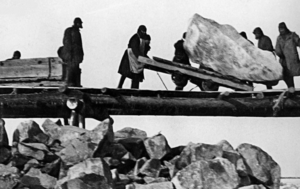Concentration camp facts for kids
A concentration camp is a place where a government makes many people live. Usually, these people belong to groups the government does not like. The government might think these people are its enemies. In the past, governments have also put people in these camps because of their religion, race, or ethnic group.
People are usually sent to concentration camps without a trial. They are not found guilty of a crime. Sometimes, governments send people to these camps for forced labor or to be killed. For example, Nazi Germany used concentration camps during World War II. The Nazis killed millions of people there. They also forced many others to work as slaves. Many countries have used concentration camps during wars or times of trouble.
Contents
Early Camps
Native American "Reservations"

The first modern concentration camps in the United States were created in 1838. At this time, the United States was growing. But Native Americans lived in the lands the United States wanted.
In 1830, the U.S. government passed a law called the Indian Removal Act. This law said all Native Americans had to move west of the Mississippi River. Many Cherokee people would not leave their lands. So, in May 1838, the U.S. government forced the Cherokee to leave.
First, soldiers forced about 17,000 Cherokee people and 2,000 of their African-American slaves into camps. They lived there during the summer of 1838. 353 Cherokee people died in the camps from diseases. Finally, the Cherokee were forced to travel to what is now Oklahoma. The government also forced other Native American tribes to move west.
Later, many people from the United States moved west again. They moved into Native American lands. Starting around the 1860s, many Native American tribes fought back. These fights are called the Indian Wars. The U.S. government reacted by forcing Native Americans into camps again. The government called these camps "Indian reservations." Native Americans were not allowed to leave these reservations. On some, many people, especially children, died from hunger and sickness.
American Civil War Camps
During the American Civil War in the 1860s, captured soldiers were sometimes put in camps. These were meant to be prisoner of war (POW) camps. But as the war went on, both sides captured more enemy soldiers. The camps became very crowded. Conditions were terrible. There was not enough food, and many men died from hunger. There was also very little sanitation, which helped diseases spread.
The deadliest POW camp was Andersonville prison. It was run by the Confederate States Army. At Andersonville, 12,920 Union Army prisoners died. This was more than one out of every four prisoners.
Conditions at the Union's POW camps were also very bad. At four Union camps, at least 15% of the prisoners died. At a camp called Fort Pulaski, Union soldiers purposely starved 600 Confederate prisoners. 46 of them died. They did this to get revenge for how Union prisoners were treated at Andersonville.
By the end of the Civil War, about 30,000 Union soldiers and 26,000 Confederate soldiers had died in POW camps.
Camps in Cuba
In the late 1800s, Cuba was controlled by Spain. When Cuban people tried to fight for independence from 1895 to 1898, Spain created concentration camps. They sent many Cuban people to live in them. This was called the "Reconcentrado" Policy.
The Cuban fighters were guerrilla fighters. They did not wear military uniforms and could hide among regular people. They could also camp and hunt to survive. To stop this, the Spanish government put Cuban people in camps. The idea was to 'protect' them until Spain won the war. But this idea did not work. At least 30% of the Cuban people in the camps died from hunger, disease, and lack of medicine. The camps also did not help Spain win the war.
Camps in the Early 1900s
The British Empire
Between 1900 and 1902, the British Empire used concentration camps. They were fighting the Boer people in the Second Boer War in South Africa. At first, the British could not beat the Boers. So, they put the Boer fighters' family members into camps. This was to stop them from giving food or help to the fighters. The British soldiers also burned down Boer houses and farms. They destroyed all crops. This was to make it hard for Boer fighters to find food or shelter.
Around 26,000 women and children died in these camps from disease and starvation.
Russia & the Soviet Union
Russia used prison camps, especially in places like the Arctic or Siberia. The first prison camp in Russia was built in 1918. But after the Soviet Union was formed in 1922, the Soviet government sent many more people to forced labor camps.
These camps are often called "gulags." "GULAG" was the name of the government agency in charge of these camps. This was when Joseph Stalin led the Soviet Union. People often use "gulag" to talk about any forced labor camp in Russia or the Soviet Union.
People sent to the gulags included:
- People who disagreed with the Soviet government.
- People who were not communists.
- People who practiced certain religions.
- People from ethnic groups the government did not trust.
- Members of the Communist Party and the Red Army that Stalin disliked.
- People the government thought were traitors or criminals.
- People who had not done anything wrong.
Camps During World War II
Nazi Germany
During World War II, Nazi Germany created many concentration camps, slave labor camps, and death camps. Nazi Germany's leader, Adolf Hitler, believed some groups of people were not as good as others. He even thought some groups did not deserve to live. These groups included Jews, Roma people, and people with disabilities. Hitler wanted his Nazis to kill every Jew, Roma, and disabled person in Europe.
Hitler also wanted to get rid of other groups he disliked. These included socialists, communists, people of certain religions, and members of resistance movements.
The Nazis sent many of these people to concentration camps to work as slave labor. After a few years, some camps were set up just to kill people. These are called "extermination camps" or "death camps." At these camps, people were killed in gas chambers, shot, or worked to death. Many also died from disease and starvation.
More than half of the Jewish people who died in the Holocaust died at Nazi concentration camps. In the Auschwitz camps alone, at least 1.1 million people died. This included about 1,000,000 Jews. Towards the end of World War II, the Nazis killed up to 20,000 people a day in the camps' gas chambers.
Japanese-American Internment Camps

During World War II, the United States forced over 110,000 Japanese-Americans into internment camps.
On December 7, 1941, Japan attacked Pearl Harbor, Hawaii. In February 1942, the U.S. government ordered that no one with Japanese ancestry could live on the West Coast. The government, led by President Franklin D. Roosevelt, thought Japanese-American people might be spies for Japan.
About 80% of the Japanese-American people living in the U.S. were forced to leave their homes. They had to live in internment camps. More than three out of five of these people were born in the United States and were U.S. citizens.
After Canada declared war on Japan, it also forced people with Japanese ancestry into internment camps.
In the 1980s, the U.S. government said that Japanese-Americans were not a danger during World War II. In 1988, President Ronald Reagan signed a law that apologized for the internment camps. The law said there was no real reason for the internment. It said the internment was caused by racial prejudice and fear.
Italy
During World War II, Italy's fascist government was Nazi Germany's ally. Italy had taken over parts of Yugoslavia, Greece, and France. The Nazis told Italy to put Jews from these areas in concentration camps. Then they wanted Italy to send them to Nazi death camps. However, Italy refused. The Italian military and police would not help kill or deport Jews.
But in 1943, after Mussolini had lost power, Nazi Germany took over northern and central Italy. They also put Mussolini back in power. The Nazis created concentration camps to hold Italian Jews and other prisoners. They would then send them to death camps. In one camp, called La Risiera di San Sabba, the Nazis harmed and killed about 5,000 people. Many of these were "political prisoners" who disagreed with the government.
Soviet Union
When Joseph Stalin and the Soviet Union invaded Poland at the start of World War II, the Red Army forced at least 1.5 million Poles to leave. They were forced into cattle wagons, which took them to Siberia. Whole families were sent to concentration camps, including children and the elderly.
During the war, the Soviet Union also used gulags. They held prisoners of war from Nazi Germany and its allies.
Camps in the Late 1900s
Latin America
During the 1970s and 1980s, many military dictatorships in Latin America set up concentration camps. They used these to imprison, harm, and kill people who disagreed with them. For example:
- Argentina created over 300 concentration camps during the Dirty War.
- Chile, led by Augusto Pinochet, created 17 concentration camps. They used these camps to harm prisoners. Many prisoners then "disappeared." This meant the military killed them, and their bodies were never found. While Pinochet was in power, 28,000 people were harmed. 2,279 people were killed, and 1,248 people "disappeared."
- Cuba, led by Fidel Castro, used forced labor camps from 1965 to 1968. These were for people Castro thought were bad for Cuba. His government thought they could "re-educate" these people by making them work. People sent to the camps included homosexuals, people without homes or jobs, Jehovah's Witnesses, other religious missionaries, and people who disagreed with the communist government.
Soviet Union
The Soviet Union kept using forced labor camps after World War II. They even sent Soviet soldiers and regular people who had been captured by the Nazis to the gulags.
By 1956, between 15 million and 30 million people had died or been killed in the gulags.
In 1973, Aleksandr Solzhenitsyn, a Russian author, wrote The Gulag Archipelago. It was about his experiences in a Soviet work camp.
The Soviet Union kept using gulags until the late 1980s. It closed its last forced labor camp in 1988.
Camps in the 2000s
Since January 2002, the United States has run the Guantánamo Bay prison camp. Some people have called Guantánamo a concentration camp or a gulag. These people include Fidel Castro and groups like Amnesty International.
Photo gallery
-
Prisoner beds at Fort Pulaski, where Confederate POWs were starved on purpose
Images for kids
-
Ten thousand inmates were kept in El Agheila, one of the Italian concentration camps in Libya during the Italian colonization of Libya
See also
 In Spanish: Campo de concentración para niños
In Spanish: Campo de concentración para niños









